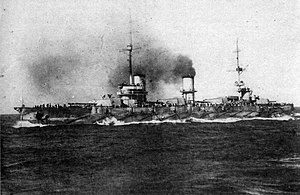Russian battleship Imperator Aleksander III

Volia at sea
|
|
| History | |
|---|---|
|
|
|
| Name: | Imperator Aleksandr III |
| Namesake: | Czar Alexander III |
| Operator: | Imperial Russian Navy |
| Ordered: | 13 April 1912 |
| Builder: | Russud Shipyard, Nikolayev |
| Laid down: | 30 October 1911 |
| Launched: | 15 April 1914 |
| In service: | 17 July 1917 |
| Renamed: | Volia (Freedom) on 29 April 1917 |
|
|
|
| Name: | Volia |
| Operator: | Red Fleet |
| Acquired: | November 1917 |
| Fate: | Turned over to the German Empire 19 June 1918 |
|
|
|
| Name: | Volia |
| Operator: | German Empire |
| Acquired: | 19 June 1918 |
| Fate: | turned over to the United Kingdom 24 November 1918 |
| Name: | General Alekseyev |
| Namesake: | Mikhail Alekseyev |
| Operator: | White Movement |
| Acquired: | 1 November 1919 |
| Out of service: | 29 December 1920 |
| Renamed: | General Alekseyev November 1919 |
| Fate: | Scrapped 1936 |
| General characteristics | |
| Class and type: | Imperatritsa Mariya-class battleship |
| Displacement: | 23,413 long tons (23,789 t) |
| Length: | 168 m (551 ft) |
| Beam: | 27.43 m (90.0 ft) |
| Draft: | 8.36 m (27.4 ft) |
| Propulsion: |
|
| Speed: | 21 knots (39 km/h; 24 mph) |
| Range: | 1,640 nautical miles (3,037 km) at 21 knots (39 km/h; 24 mph) |
| Complement: | 1,154 |
| Armament: |
|
| Armor: |
|
Imperator Aleksandr III (Emperor Alexander III) was the third, and last, ship of the Imperatritsa Mariya-class dreadnoughts of the Imperial Russian Navy. She was begun before World War I, completed in 1917 and saw service with the Black Sea Fleet. She was renamed Volia or Volya (Russian: Вóля, Freedom) before her completion and then General Alekseyev (Russian: Генерал Алексеев) in 1920. The ship did not take part in operations during World War I because her sister ships were given a higher priority for completion. She was delivered in 1917, but the disruptions of the February Revolution rendered the Black Sea Fleet ineffective and she saw no combat.
Volia was surrendered to the Germans in 1918, but they were forced to turn her over to the British by the terms of the Armistice. The British turned her over to the White Russians in 1919 and they used her to help evacuate the Crimea in 1920. She was interned in Bizerte by the French and ultimately scrapped by them in 1936 to pay her docking fees. Her guns were put into storage and were later used by the Germans and Finns for coastal artillery during World War II. The Finns and the Soviets continued to use them throughout the Cold War.
Imperator Aleksandr III was 168 meters (551 ft) long at the waterline. She had a beam of 27.43 meters (90.0 ft) and a draft of 8.36 meters (27.4 ft). Her displacement was 23,600 tonnes (23,200 long tons; 26,000 short tons) at load, 1,000 t (980 long tons; 1,100 short tons) more than her designed displacement of 22,600 t (22,200 long tons; 24,900 short tons).Imperatritsa Mariya had proved to be very bow heavy in service and tended to ship large amounts of water through her forward casemates.Imperator Aleksandr III's forward pair of 130 mm guns were removed before she was completed in an attempt to compensate for her trim.
...
Wikipedia
